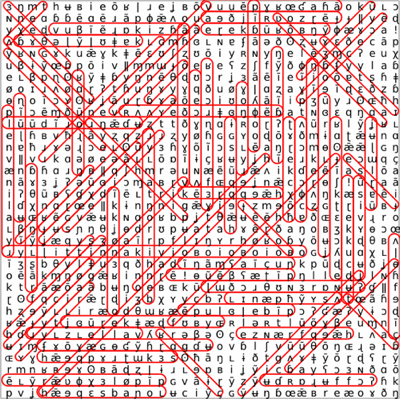Vallelz Noun Class Word Search Solution
provided by the SpecGram Puzzle Elves™
Once again we have been sorely disappointed by our readers, who we had taken to be lazy, shiftless slackers unable and unwilling to undertake any even remotely demanding task. Alas, several readers have actually managed to solve the Vallelz Noun Class Word Search from the May 2010 issue. The puzzlemeisters below have done so, and will be rewarded appropriately:
Bryan Allen •
Adam Bernard •
Madalena Cruz-Ferreira
Adam Hesterberg •
Philip Newton •
vu-Blank-ɦā
|
The table below lays out the semantic noun classes, definite affixes, and inflected definite forms of the Vallelz nouns from the puzzle:
| | gloss | | indefinite | | definite |
| Class: human languages; Affix: -ʟyɹ |
| Benhirloŋtam | | benhirroŋtam | | benhirroŋtamʟyɹ |
| Oboioboioboiwikantsitstil | | oʙoioʙoioʙoivikannittiɭ | | oʙoioʙoioʙoivikannittiɭʟyɹ |
| Pirahã | | pirahã | | pirahãʟyɹ |
| Ple Nvæn-ila | | plenvænila | | plenvænilaʟyɹ |
| Swedish | | svediʃ | | svediʃʟyɹ |
| Vallelz | | valleʟz | | valleʟzʟyɹ |
| Winodanugai | | vinodanugai | | vinodanugaiʟyɹ |
| Xoŋry | | ɣoŋʀʏ | | ɣoŋʀʏʟyɹ |
| Class: food animals; Affix: -ʘɑʁ |
| chicken | | eɖʎɔʒɛʈkʃīɟ | | eɖʎɔʒɛʈkʃīɟʘɑʁ |
| duck | | ɢœ | | ɢœʘɑʁ |
| goose | | ŋəɻɻoū | | ŋəɻɻoūʘɑʁ |
| pig | | çɨɘ | | çɨɘʘɑʁ |
| rabbit | | ʋōʐēɓōɖ | | ʋōʐēɓōɖʘɑʁ |
| Class: work animals; Affix: -ɽek- |
| bee | | ʈɤcχōħ | | ʈɤɽekcχōħ |
| dog | | ʝɞūǂæɖfʊʙyɶ | | ʝɞūɽekǂæɖfʊʙyɶ |
| donkey | | ʐʌmmũɴʒīiŋ | | ʐʌɽekmmũɴʒīiŋ |
| elephant | | ǃæɰucɖʉt | | ǃæɽekkucɖʉt |
| horse | | eɓūʁōʙŋȳ | | eɽekɓūʁōʙŋȳ |
| Class: semi-edible animals; Affix: -ɱyt- |
| cat | | ɓa | | ɓaɱyt |
| cow | | ʏʟrā | | ʏɱytʟrā |
| goat | | ɤðħɪ | | ɤɱytðħɪ |
| llama | | fāʂ | | fāɱytʂ |
| sheep | | ɢɛʝnoħɤɹ | | ɢɛɱytʝnoħɤɹ |
| Class: round things; Affix: ʌ- |
| frisbee | | ǀɵɦfɘɖīç | | ʌǀɵɦfɘɖīç |
| oranges | | ɴɨõøɣɔeqʊ | | ʌɴɨõøɣɔeqʊ |
| silo | | sʏỹħpænɪʟ | | ʌsʏỹħpænɪʟ |
| tractor tire | | ʁɨpʌʏ | | ʌʁɨpʌʏ |
| wagon wheel | | χet | | ʌχet |
| Class: vermin; Affix: vu- -ɦā |
| bedbug | | ynɯʃ | | vuunɯʃɦā |
| linguist | | βīẽɻɒkiz | | vuβīẽɻɒkizɦā |
| locust | | ĩɣyððōɣɖōʐ | | vuĩɣyððōɣɖōʐɦā |
| mouse | | āmʊmŋ | | vuāmʊmŋɦā |
| weevil | | yēpɣʁœʛa | | vuuēpɣʁœʛaɦā |
| Class: scientific objects; Affix: pī- -ē |
| calculus | | pølɜχɸʋǣrỹʟ | | pīpølɜχɸʋǣrỹʟē |
| laptop | | ʈæʕβēũɵǃ | | pīʈæʕβēũɵǃē |
| solar panel | | ɓāɴʃãǀʎɸoo | | pīɓāɴʃãǀʎɸooē |
| sudoku | | beǀɞlup | | pībeǀɞlupē |
| water pump | | oʄceɔ | | pīoʄceɔē |
| |
| | gloss | | indefinite | | definite |
| Class: sub-human languages; Affix: hǣɘq- |
| English | | æŋliʒ | | hǣɘqæŋliʒ |
| French | | fræɴze | | hǣɘqfræɴze |
| German | | æledʒeɽdoɪtθ | | hǣɘqæledʒeɽdoɪtθ |
| Italian | | italiano | | hǣɘqitaliano |
| Latin | | ɢɽɜēk | | hǣɘqqɽɜēk |
| Portuguese | | pɤɹʈɯkɜs | | hǣɘqpɤɹʈɯkɜs |
| Russian | | ʀʀũʉsɢɨ | | hǣɘqqũʉsɢɨ |
| Spanish | | ɛsbaɲoʟ | | hǣɘqɛsbaɲoʟ |
| Class: edible plants; Affix: ʝʉ- -ū |
| blueberry | | ɢœχɞqã | | ʝʉɢœχɞqãū |
| garlic | | ɭɯlɽɐ | | ʝʉɭɯlɽɐū |
| pumpkin | | ʌʛõfūgiȳ | | ʝʉʌʛõfūgiȳȳ |
| rice | | ʙɶɢŋɵẽʟɵɨrɞ | | ʝʉʙɶɢŋɵẽʟɵɨrɞū |
| wheat | | ɑɖʏvis | | ʝʉɑɖʏvisū |
| Class: inedible plants; Affix: -ŋĩ |
| artichoke | | ūǁæɛʒ | | ūǁæɛʒŋĩ |
| bamboo | | ŋỹīʐĩɓʔō | | ŋỹīʐĩɓʔōŋĩ |
| cotton | | ʙəʕɑʁ | | ʙəʕɑʁŋĩ |
| sunflower | | oɖʉʁɜnøʝk | | oɖʉʁɜnøʝkkĩ |
| tulip | | ɲuçīaʕɱã | | ɲuçīaʕɱãŋĩ |
| Class: humans; Affix: -ɽẽɟ |
| child | | aɘðjīʀʋoz | | aɘðjīʀʋozɽẽɟ |
| farmer | | aʏʐzʘəǁūɠ | | aʏʐzʘəǁūɠɽẽɟ |
| man | | ʙo | | ʙoɽẽɟ |
| scarecrow | | fēcɭēʕʙøɽhōɸ | | fēcɭēʕʙøɽhōɸɽẽɟ |
| woman | | es | | esɽẽɟ |
| Class: human powered tools; Affix: -ɗʉ |
| hoe | | ɳĩūɭɐǁnãʔ | | ɳĩūɭɐǁnãʔɗʉ |
| lawnmower | | ʄɤōɣæɢɵʛỹɦɽɑg | | ʄɤōɣæɢɵʛỹɦɽɑgɗʉ |
| rake | | ʔɔffʉɻɒʀ | | ʔɔffʉɻɒʀɗʉ |
| scythe | | lūūdĩɹoɹŋǣ | | lūūdĩɹoɹŋǣɗʉ |
| wheelbarrow | | ǂøōcȳɟ | | ǂøōcȳɟɗʉ |
| Class: other tools; Affix: -θɤɓ |
| combine | | ɵɴɠœʔβɘ | | ɵɴɠœʔβɘθɤɓ |
| harvester | | rāʂʟȳŋɶχ | | rāʂʟȳŋɶχθɤɓ |
| hay baler | | ɜne | | ɜneθɤɓ |
| plow | | kɐǂʊǀỹɭə | | kɐǂʊǀỹɭəθɤɓ |
| tractor | | ō | | ōθɤɓ |
| Class: red things; Affix: -ðɔɹ- |
| big barn | | ɭɯθʊɴɜrɒɴʉʔ | | ɭɯðɔɹθʊɴɜrɒɴʉʔ |
| cardinal (bird) | | ʌɗɔɸcɐ | | ʌðɔɹɗɔɸcɐ |
| strawberry | | eãoββỹ | | eãoðɔɹββỹ |
| tomato | | ʁɔɳɦĩçæfɜɣ | | ʁɔðɔɹɳɦĩçæfɜɣ |
| toy wagon | | ʀʌʌʏeǂɞŋɸẽɓ | | ʀʌʌʏeðɔɹǂɞŋɸẽɓ |
|
Several of the puzzlemeisters who submitted their solutions also made decent guesses as to the semantic classes of the nouns above. Some of the more interesting choices included: “interesting” vs “boring” languages, languages with and without “an imperialistic past”, “white meat” animals, “animals one would be ill-advised to kick”, “ruminants (cats are included for their hairballs)”, animals that “can balance on one pair of both forelimbs and hind limbs unaided”, animals that “can balance only on one pair of hind limbs unaided”, “Thanksgiving must-eats”, and items “of limited entertainment value in a night-club”. Interestingly, only vu-Blank-ɦā got all of the semantic classes exactly right.
There are a few simple phonological rules that affect the words after affixation. Consonants and vowels are divided into several classes. When two vowels or consonants of the same class are adjacent, the second assimilates to the first. In the cases where this results in more than two identical phonemes in a row, they are reduced to only two. The consonant and vowel classes are:
| t d n r l ɹ s z |
p b m ʙ ɸ β |
ɓ ɗ ʄ ɠ ʛ |
θ ð ʃ ʒ |
i y ʏ ɪ ɨ ʉ ʊ ɯ u |
e ø ɘ ɵ ɤ o |
| ʈ ɖ ɳ ɽ ʂ ʐ ɻ ɭ |
c ɟ ɲ ç ʝ j ʎ |
ɱ f v ʋ |
ʔ h ɦ |
ȳ ā ē ǣ ī ō ū |
ɛ œ ɜ ɞ ʌ ɔ |
| k g ŋ x ɣ ɰ ʟ |
q ɢ ɴ ʀ χ ʁ |
ʘ ǀ ǃ ǂ ǁ |
ħ ʕ |
ə |
æ ɶ a ɐ ɑ ɒ |
ã ẽ ĩ õ ũ ỹ |
For those who want to know the specific locations of the definite forms of the various nouns in the original word search, the solution is shown below.

 |
Out-of-this-World Fieldwork Puzzle #1—Pecha Kucha |
 |
SpecGram Vol CLIX, No 3 Contents |
